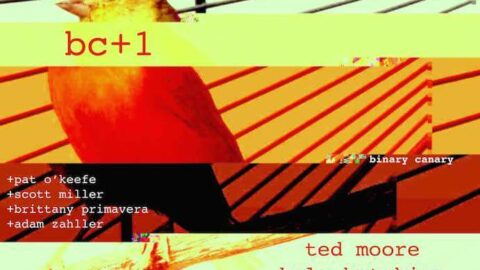What must it be like when Jeffery Kyle Hutchins (saxophone) and Ted Moore (laptop) invite you to join them in an improvisation? Do they prime the pump by suggesting a vibe, a pace, an affect? Do they keep their thoughts to themselves and suggest with their instruments once the tape starts to roll? Do Hutchins and Moore try to keep their guests in the air like shuttlecocks, or are they more like John C. McGinley and Paul Willson in Office Space? What would they say one does here, I wonder?
On their self-released bc+1, Hutchins and Moore—the duo known as Binary Canary—recruit four guest improvisers to catalyze four unique results. Habitués of the Twin Cities new music scene will recognize Pat O’Keefe (clarinet), Scott Miller (laptop), and Adam Zahller (bass recorder); the fourth, Brittany Primavera (alto flute), is Kyle Hutchins’s partner in the AVIDduo.
The terrain into which these four interlopers parachute—that is, the ambitus of Binary Canary’s musical possibility-space—is craggy, and its promontories and crevices offer productive asymmetries for its explorers to leap from, hop across, and set up camp within. The most salient such asymmetry is this: Hutchins has to blow into his instrument, expending precious physical energy, to get it to do anything; Moore, given the proper preparation, can produce any sound he can imagine at any time with the merest touch of a key.

What’s really at stake in bc+1 is scarcity. Hutchins, Moore, and their guests are skilled improvisers, no doubt about it, and they can produce as much and as varied material as their hardware, software, and wetware will allow. They, even the woodwind players, inhabit a post-scarcity sonic environment. How do the musicians on this record reckon with the cornucopic abundance of sound (i.e., quantitative) and kinds of sound (i.e., qualitative) spread out on the table before them, spilling like pumpkins and corn from the bells of axes and the cones of speakers?
On bc+1’s first track, Pat O’Keefe—well-known to Minnesota audiences as a quarter of Zeitgeist—is clearly determined to plumb the depths of that very question. Wheeling around an elusive gestural core in increasingly wide orbits, O’Keefe and Binary Canary seem to be probing each other, running some diagnostics to see how far afield of their starting point they’re willing to go. The mechanical similarity between Hutchins’s instrument and O’Keefe’s sometimes appears to be the nucleus of this improvisation; at other times, it seems like an optical illusion, a coincidence. O’Keefe puts the concept of bc+1 through its paces at a rate that’s frankly unsafe. Everything is strongly characterized, but nothing is as it seems.
The second track couldn’t be more different from the first: maybe the silhouette of Scott Miller, a capital-C Composer, should have been a tip-off. As it turns out, this number is the album’s tightest, its most single-minded and parsimonious with material. This trio banks the fire of the previous improvisation, choosing instead to focus on microscopic changes and freight every development with portent. If O’Keefe seems to push Binary Canary, Miller seems to pull them.

But the model that enables that sort of metaphor isn’t long for bc+1. In the album’s second half, the duo trades its single-reed and laptop doppelgängers for the pastoral plaints of alto flute and bass recorder, and the matter of abundance is broached in a new way. Brittany Primavera’s turn, mercurial yet cogent, is marked by a moldering surplus of melody; the funhouse-mirror distortions to which each woodwind subjects the other and the broken-mirror fracturing of both by Moore put lyricism on trial. Finally, Adam Zahller’s especially eccentric contribution to bc+1 achieves a comparable outcome by altogether different means, alienating its creepily simple material through repetition, near-repetition, and not-really-repetition-but-it-somehow-seems-familiar-anyway. I found this last piece to contain the most uncanny and disturbing music on the record.
It might be blithe to observe that the improvisations in which Binary Canary is joined by people who identify foremost as composers—Miller and Zahller—sound the most like composed pieces that emerged from a single subjectivity, whereas the improvisations featuring people who identify foremost as performers—O’Keefe and Primavera—feel more like conversations, contestations, and sometimes even consolations. And it might be reductive to claim that in each of the record’s two diptychs—its first and second halves—the first piece and the second seem to grapple in contrastive ways with similar musical problems. On the other hand, it’s difficult to imagine that these symmetries are accidental. That bc+1 could make room for so much sound, so much chaos, all arising in the moment of improvisation, and yet also yield such vivid contradictions and concordances is its biggest success.
























